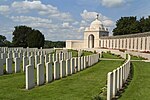Battle of Polygon Wood

The Battle of Polygon Wood took place from 26 September to 3 October 1917, during the second phase of the Third Battle of Ypres in the First World War. The battle was fought near Ypres in Belgium, in the area from the Menin road to Polygon Wood and thence north, to the area beyond St Julien. Much of the woodland had been destroyed by the huge quantity of shellfire from both sides since 16 July and the area had changed hands several times. General Herbert Plumer continued the series of British general attacks with limited objectives. The attacks were led by lines of skirmishers, followed by small infantry columns organised in depth (a formation which had been adopted by the Fifth Army in August) with a vastly increased amount of artillery support, the infantry advancing behind five layers of creeping barrage on the Second Army front. The advance was planned to cover 1,000–1,500 yd (910–1,370 m) and stop on reverse slopes, which were easier to defend, enclosing ground which gave observation of German reinforcement routes and counter-attack assembly areas. Preparations were then made swiftly to defeat German counter-attacks, by mopping-up and consolidating the captured ground with defences in depth. The attack inflicted a severe blow on the German 4th Army, causing many losses, capturing a significant portion of Flandern I Stellung, the fourth German defensive position, which threatened the German hold on Broodseinde ridge. The drier weather continued to benefit the British attackers by solidifying the ground and raising mist which obscured British infantry attacks made around dawn. The mist cleared during the morning and revealed German Eingreif (counter-attack) formations to air and ground observation, well in advance of their arrival on the battlefield. German methodical counter-attacks (Gegenangriffe) from 27 September – 3 October failed and German defensive arrangements were changed hastily after the battle to try to counter British offensive superiority.
Excerpt from the Wikipedia article Battle of Polygon Wood (License: CC BY-SA 3.0, Authors, Images).Battle of Polygon Wood
Oude Kortrijkstraat,
Geographical coordinates (GPS) Address Nearby Places Show on map
Geographical coordinates (GPS)
| Latitude | Longitude |
|---|---|
| N 50.851944444444 ° | E 2.9852777777778 ° |
Address
Oude Kortrijkstraat
Oude Kortrijkstraat
8980
West Flanders, Belgium
Open on Google Maps







